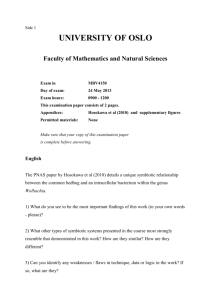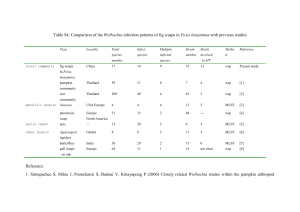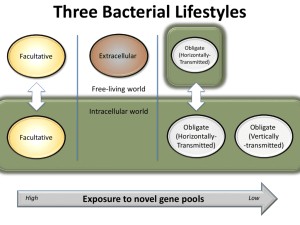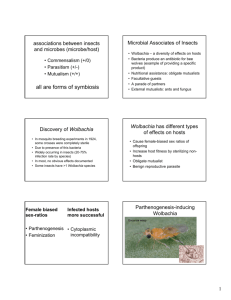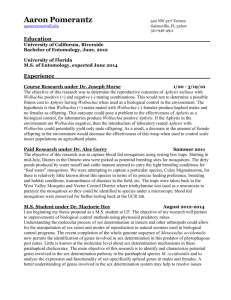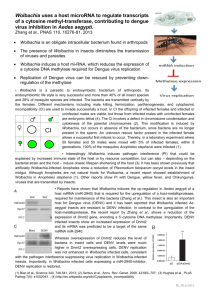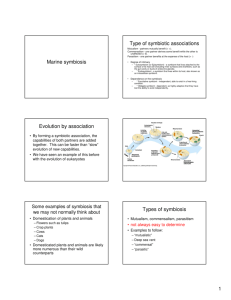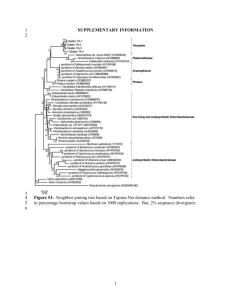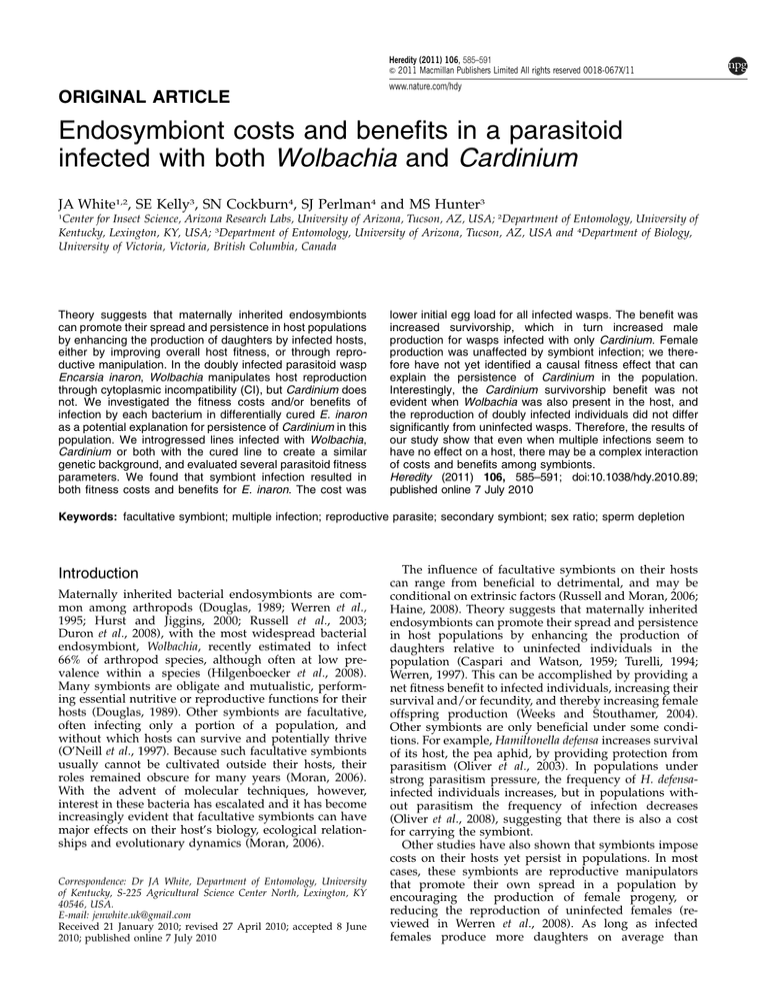
Heredity (2011) 106, 585–591
& 2011 Macmillan Publishers Limited All rights reserved 0018-067X/11
ORIGINAL ARTICLE
www.nature.com/hdy
Endosymbiont costs and benefits in a parasitoid
infected with both Wolbachia and Cardinium
JA White1,2, SE Kelly3, SN Cockburn4, SJ Perlman4 and MS Hunter3
Center for Insect Science, Arizona Research Labs, University of Arizona, Tucson, AZ, USA; 2Department of Entomology, University of
Kentucky, Lexington, KY, USA; 3Department of Entomology, University of Arizona, Tucson, AZ, USA and 4Department of Biology,
University of Victoria, Victoria, British Columbia, Canada
1
Theory suggests that maternally inherited endosymbionts
can promote their spread and persistence in host populations
by enhancing the production of daughters by infected hosts,
either by improving overall host fitness, or through reproductive manipulation. In the doubly infected parasitoid wasp
Encarsia inaron, Wolbachia manipulates host reproduction
through cytoplasmic incompatibility (CI), but Cardinium does
not. We investigated the fitness costs and/or benefits of
infection by each bacterium in differentially cured E. inaron
as a potential explanation for persistence of Cardinium in this
population. We introgressed lines infected with Wolbachia,
Cardinium or both with the cured line to create a similar
genetic background, and evaluated several parasitoid fitness
parameters. We found that symbiont infection resulted in
both fitness costs and benefits for E. inaron. The cost was
lower initial egg load for all infected wasps. The benefit was
increased survivorship, which in turn increased male
production for wasps infected with only Cardinium. Female
production was unaffected by symbiont infection; we therefore have not yet identified a causal fitness effect that can
explain the persistence of Cardinium in the population.
Interestingly, the Cardinium survivorship benefit was not
evident when Wolbachia was also present in the host, and
the reproduction of doubly infected individuals did not differ
significantly from uninfected wasps. Therefore, the results of
our study show that even when multiple infections seem to
have no effect on a host, there may be a complex interaction
of costs and benefits among symbionts.
Heredity (2011) 106, 585–591; doi:10.1038/hdy.2010.89;
published online 7 July 2010
Keywords: facultative symbiont; multiple infection; reproductive parasite; secondary symbiont; sex ratio; sperm depletion
Introduction
Maternally inherited bacterial endosymbionts are common among arthropods (Douglas, 1989; Werren et al.,
1995; Hurst and Jiggins, 2000; Russell et al., 2003;
Duron et al., 2008), with the most widespread bacterial
endosymbiont, Wolbachia, recently estimated to infect
66% of arthropod species, although often at low prevalence within a species (Hilgenboecker et al., 2008).
Many symbionts are obligate and mutualistic, performing essential nutritive or reproductive functions for their
hosts (Douglas, 1989). Other symbionts are facultative,
often infecting only a portion of a population, and
without which hosts can survive and potentially thrive
(O’Neill et al., 1997). Because such facultative symbionts
usually cannot be cultivated outside their hosts, their
roles remained obscure for many years (Moran, 2006).
With the advent of molecular techniques, however,
interest in these bacteria has escalated and it has become
increasingly evident that facultative symbionts can have
major effects on their host’s biology, ecological relationships and evolutionary dynamics (Moran, 2006).
Correspondence: Dr JA White, Department of Entomology, University
of Kentucky, S-225 Agricultural Science Center North, Lexington, KY
40546, USA.
E-mail: jenwhite.uk@gmail.com
Received 21 January 2010; revised 27 April 2010; accepted 8 June
2010; published online 7 July 2010
The influence of facultative symbionts on their hosts
can range from beneficial to detrimental, and may be
conditional on extrinsic factors (Russell and Moran, 2006;
Haine, 2008). Theory suggests that maternally inherited
endosymbionts can promote their spread and persistence
in host populations by enhancing the production of
daughters relative to uninfected individuals in the
population (Caspari and Watson, 1959; Turelli, 1994;
Werren, 1997). This can be accomplished by providing a
net fitness benefit to infected individuals, increasing their
survival and/or fecundity, and thereby increasing female
offspring production (Weeks and Stouthamer, 2004).
Other symbionts are only beneficial under some conditions. For example, Hamiltonella defensa increases survival
of its host, the pea aphid, by providing protection from
parasitism (Oliver et al., 2003). In populations under
strong parasitism pressure, the frequency of H. defensainfected individuals increases, but in populations without parasitism the frequency of infection decreases
(Oliver et al., 2008), suggesting that there is also a cost
for carrying the symbiont.
Other studies have also shown that symbionts impose
costs on their hosts yet persist in populations. In most
cases, these symbionts are reproductive manipulators
that promote their own spread in a population by
encouraging the production of female progeny, or
reducing the reproduction of uninfected females (reviewed in Werren et al., 2008). As long as infected
females produce more daughters on average than
Interactive endosymbiont fitness effects
JA White et al
586
uninfected females, the symbiont can persist and spread
in the population, even if total progeny production is
reduced (Caspari and Watson, 1959; Turelli, 1994;
Werren, 1997). Over time, one would expect evolution
toward reduced cost in such systems, because of the
strictly vertical transmission and the shared fate between
host and symbiont (Weeks et al., 2007). However, there
are situations in which detrimental effects may persist. In
particular, multiple symbiont infection within a shared
host may tend to foster competitive interactions, higher
symbiont titer and increased cost to the host (Oliver et al.,
2006; but see Engelstadter et al., 2007). It has even been
theorized that under some conditions coinfection may
allow cost-inflicting symbionts to ‘hitchhike’ with more
beneficial partners, and invade a host population that
could not be invaded by the cost-inflicting symbiont
alone (Vautrin et al., 2007).
Infection by multiple symbionts is reasonably common
(Duron et al., 2008), yet there has been relatively little
work on fitness consequences of multiple infections for
hosts, nor the individual cost or benefit derived from
each symbiont. Most studies have focused on multiple
coinfecting strains of a single symbiont (the most
common symbiont, Wolbachia; Mouton et al., 2004),
and/or comparing populations of hosts that are naturally infected with different symbiont combinations
(Narita et al., 2007; Ros and Breeuwer, 2009). The latter
type of study is often the only type possible for some
relatively intractable systems, but does not control for
host genotype differences among populations, nor does
it allow dissection of each symbiont’s contribution to the
phenotype of multiply infected hosts, as symbionts in
singly infected hosts have a different evolutionary
context from their coinfecting counterparts and may
differ substantially in their effects on the host.
The goal of this study was to investigate the fitness
costs and/or benefits exerted by multiple symbionts in a
coinfected host. Encarsia inaron (Hymenoptera: Aphelinidae) is an introduced parasitic wasp that has both
Wolbachia and Cardinium endosymbionts (Perlman et al.,
2006). Wolbachia is an a-Proteobacteria that has been
shown to maintain its prevalence within many arthropod
taxa through a variety of reproductive manipulations
(Werren et al., 2008). Cardinium is a more recently
described symbiont that is not closely related to
Wolbachia (Cardinium is a member of the Bacteroidetes),
yet is capable of a similar array of reproductive
manipulations (Zchori-Fein et al., 2001, 2004; Hunter
et al., 2003). In E. inaron, Wolbachia was shown to cause
CI, whereby matings between infected males and
uninfected females do not produce viable female offspring (White et al., 2009). Cardinium, however, did not
cause CI, nor did it interact with the Wolbachia-induced
CI phenotype. We therefore investigated symbiont
influence on host fitness as a potential explanation for
the persistence of Cardinium in the wasp population.
Materials and methods
Cultures
E. inaron is a minute parasitoid (o1 mm) that develops as
a primary parasitoid in a variety of whitefly species
(family Aleyrodidae, Manzari et al., 2002). The doubly
infected E. inaron culture (‘both’) originated from
Heredity
Siphoninus phillyreae pupae collected in Tucson, Arizona
in 2002, and has been propagated on sweet potato
whitefly (Bemisia tabaci) in the laboratory as described in
Perlman et al. (2006). This population of B. tabaci does not
contain either Cardinium or Wolbachia (Zchori-Fein and
Brown, 2002), and therefore does not have the potential
to interfere with transmission or detection of these
symbionts in E. inaron. The differentially infected
cultures (‘Cardinium,’ ‘Wolbachia’ and ‘cured’) were
previously generated using low doses of antibiotics, as
described in White et al. (2009). To ensure similar genetic
backgrounds among the cultures, we carried out an
introgression series such that the genetic background of
the Cured culture replaced the background of the
Wolbachia, Cardinium and doubly infected cultures. A
total of 50 females of each infected line were mated with
cured males. Progeny of these crosses was backcrossed to
cured males for an additional seven generations, to
create four differentially infected cultures that were
genetically homogeneous (sharing 99.5% genes). We
propagated these cultures from generation to generation
using 100 mated females until the fitness assays were
conducted seven (experiment 1) or nine (experiment 2)
generations later. The infection status of each culture was
verified in the generation before the experiments and the
generation after the experiments using diagnostic PCR as
described in White et al. (2009). In both instances, all
individuals possessed the correct symbionts (24 out of 24
wasps in the preexperimental generation, 80 out of 80
wasps in the postexperimental generation).
Fitness assays
We collected fitness data in two experiments. For each
experiment, we put eight pots of cowpea plants (Vigna
ungulata) that had been previously infested with B. tabaci
into individual rearing jars and randomly assigned each
jar to receive parasitoids from one of the four wasp
cultures (two jars per culture). Each jar received 25
E. inaron females. After 14 days we collected all leaf
material with developing wasp pupae from each plant,
and placed it in an emergence jar for each culture. We
inspected each jar daily, removing all newly emerged
females. On the first day that at least 30 females emerged,
we collected these females and immediately froze them
for later determination of egg load by dissection under
50 magnification. As egg load in this species is
correlated to size (White J, unpublished data) we also
measured the hind tibia length for each wasp using a
micrometer in a compound microscope at 200 magnification.
For statistical comparisons of egg load among the
cultures, we used two-way analysis of variance (ANOVA) with infection status and experiment as fixed and
random factors, respectively, followed by Fisher’s protected least significant difference for separation of means.
We used this approach, rather than a blocked ANOVA,
because a powdery mildew was present on the plants
during the second experiment causing potential interactive effects between infection status and experiment.
To determine whether significant differences in egg load
arose from underlying differences in wasp size or
differential egg load for a given size, we conducted post
hoc two-way ANOVA on hind tibia length, as well as
analysis of covariance of egg load with hind tibia length
Interactive endosymbiont fitness effects
JA White et al
CAAA-30 ) and hcpA_R1 (50 -GAAAGTYRAGCAAGY
TCTG-30 ) for the hcpA gene (Baldo et al., 2006). The
PCR temperature profile was 94 1C for 2 min, followed by
36 cycles of 94 1C for 30 s, 53 1C for 30 s, 72 1C for 1.5 min,
followed by 70 1C for 10 min. PCR detection for Cardinium was performed using primers GyrBF43 (50 -ACT
ACGGGGCACCACTGTTCATTT-30 ) and GyrBR295 (50 GCGTGGGCATAATAGAAGTTTTGG-30 ) for the GyrB
gene. The PCR temperature profile was 94C for 3 min,
followed by 29 cycles of 94 1C for 30 s, 68 1C for 30 s, 72 1C
for 45 s, followed by 72 1C for 10 min. All negative results
were checked for DNA quality using either primers
ef1-aF139 (50 -TTGCCACACCGCTCATATCGCTTG-30 ) and
ef1-aR321 (50 -CGCTTTTCACGCTCTTCGGATTTT-30 ) for
the host nuclear gene ef1-a or H3aF (50 -ATGGCTCG
TACCAAGCAGACVGC-30 ) and H3bR (50 -ATATCCTT
RGGCATRATRGTGAC-3) for histone H3 (Colgan et al.,
1998).
587
Results
Endosymbiont infection diminished E. inaron egg load.
Cured parasitoids had larger egg loads than symbiontinfected wasps in the other three cultures
(Finfection ¼ 10.23, d.f. ¼ 3, 3, P ¼ 0.044; Figure 1). There
was no difference in egg load between experiments
(Fexp. ¼ 5.23, d.f. ¼ 1, 3.2, P ¼ 0.101), nor was there a
significant interaction between culture and experiment
(Finfection exp. ¼ 0.93, d.f. ¼ 3, 413, P ¼ 0.426). Cured parasitoids averaged 2.6 (29%) more eggs than infected
wasps. There was no evidence for an additive effect of
symbiont infection, however; E. inaron in the doubly
infected culture did not differ significantly from the
singly infected Cardinium and Wolbachia cultures.
Greater egg load in the cured culture is not solely
attributable to either larger parasitoid size or greater
egg load for a given size. Wasp size, as measured by hind
tibia length, is an important correlate of egg load
(R2 ¼ 0.55, Po0.001) but did not vary significantly among
cultures (Finfection ¼ 1.30, d.f. ¼ 3, 3, P ¼ 0.417). There were
nonsignificant trends toward larger size in experiment 2
16
no symbionts (cured)
Cardinium
14
12
10
eggload
included as a covariate. Hind tibia length was significantly correlated with egg load and did not interact
significantly with treatment: it was therefore an
appropriate covariate for this analysis.
To assess survivorship and lifetime progeny production, we collected a second group of female wasps that
were o1-day old from each culture (145 total: 10–15 per
culture in experiment 1, 24 per culture in experiment 2).
E. inaron usually mates shortly after eclosion and does
not multiply mate, but to ensure that all females had
opportunity to mate, we placed them in small groups in
35 mm ventilated Petri dishes for 24 h at a ratio of one
female to two males. All females were mated to males of
the same infection status, resulting in four treatments.
We chose to mate females and males within each
infection status, rather than mate all females to males
of a single infection status, because we wanted to
maximize the possibility of detecting among-culture
differences that could arise through differences in either
female or male quality.
We placed individual female wasps on excised cowpea
leaf disks on 1% agar medium in a 35 mm Petri dish.
Each leaf disk had approximately 50 first to third instar
B. tabaci hosts for oviposition (range ¼ 30–75 whiteflies
per disk). The Petri dishes were covered with modified
screen-top lids, and placed in an environmental chamber
at 27 1C, 60% relative humidity, 16:8 h photoperiod.
Every 24 h, we transferred each wasp to another leaf
disk until death. When a wasp died, she was frozen at
20 1C for later analysis. We recorded her cause of death,
and calculated total survivorship in days. We maintained
each leaf disk on agar for 2 weeks and quantified and
sexed the progeny that emerged. If a mother produced
no female offspring, we checked her mating status by
dissecting out her spermatheca as described in White
et al. (2009). Females that were unmated (six wasps) were
excluded from the data set.
We compared survivorship, female and male progeny
production among the cultures with two-way ANOVA as
before, excluding an additional 30 wasps that did not die
from natural causes (drowned in agar, damaged during
transfer among leaf disks or lost). To incorporate this
censored data, we also performed a Kaplan–Meier
nonparametric analysis on the survivorship data. The
results of the Kaplan–Meier and the standard ANOVA
were functionally identical, and the ANOVA met
normality and homoscedacity assumptions, so we opted
to present the ANOVA for simplicity of interpretation.
Male and female progeny data were transformed (ln and
sqrt(x þ 1), respectively) to improve conformity to normality and homoscedacity assumptions. All significant
ANOVAs were followed by Fisher’s protected least
significant difference for separation of means.
We also estimated vertical transmission efficiency of
each symbiont in all infected lines, to provide context for
observed fitness outcomes. To measure vertical transmission, we randomly selected 14–16 additional wasps from
each symbiont-infected culture, gave them 2 consecutive
days of host leaf disks (as described above) and reared
their progeny to adulthood. We extracted DNA from
each mother and all of her progeny individually
(mean ¼ 12.33±0.45 s.e. progeny per mother) using a
modified Chelex bead method (Groot et al., 2005; White
et al., 2009). PCR detection for Wolbachia was performed
using primers hcpA_F1 (50 -GAAATARCAGTTGCTG
Wolbachia
both symbionts
b
a
b
b
8
6
4
2
0
1
2
experiment
Figure 1 Mean±s.e. egg load of differentially infected E. inaron.
Lowercase letters above columns in experiment 1 denote treatments
that differed significantly at a ¼ 0.05 in a two-way ANOVA that
included both experiments.
Heredity
Interactive endosymbiont fitness effects
JA White et al
Heredity
14
no symbionts (cured)
Cardinium
b
12
Wolbachia
a
survival (days)
10
a
both symbionts
a
8
6
4
2
0
90
no symbionts (cured)
b
Cardinium
80
Wolbachia
ab
70
both symbionts
a
male offspring
(Fexp. ¼ 6.77, d.f. ¼ 1, 3.07, P ¼ 0.078) and interaction
between culture and experiment (Finfection exp. ¼ 2.58,
d.f. ¼ 3, 413, P ¼ 0.053). When hind tibia length was
included as a covariate in the analysis of egg load, there
was a nonsignificant trend for cured E. inaron to have
larger egg load than parasitoids in the infected cultures
(Finfection ¼ 7.98, d.f. ¼ 3, 3, P ¼ 0.061) with no difference
between experiments (Fexp. ¼ 1.11, d.f. ¼ 1, 3.3, P ¼ 0.363)
or interaction between culture and experiment
(Finfection exp. ¼ 1.35, d.f. ¼ 3, 412, P ¼ 0.258).
Survivorship was greatest in Cardinium-infected
E. inaron (Finfection ¼ 27.23, d.f. ¼ 3, 3, P ¼ 0.011;
Figure 2a). Survivorship was also greater in experiment
1 than experiment 2 (Fexp. ¼ 101.1, d.f. ¼ 1, 3.3, P o0.001),
but there was no interaction between culture and
experiment (Finfection exp. ¼ 0.16, d.f. ¼ 3, 101, P ¼ 0.921).
Averaged between experiments, wasps that had only
Cardinium lived 2.7 days (approximately 40%) longer
than cured wasps, 1.7 days (22%) longer than Wolbachiainfected wasps and 2.0 days (28%) longer than doubly
infected wasps. Therefore, the survivorship benefit
conferred by Cardinium was not evident in individuals
coinfected with both Cardinium and Wolbachia.
Increased survivorship in Cardinium-infected wasps
corresponded to increased male offspring production
(Finfection ¼ 22.94, d.f. ¼ 3, 3, P ¼ 0.014; Figure 2b), but not
increased female offspring production (Finfection ¼ 4.12,
d.f. ¼ 3, 3, P ¼ 0.15; Figure 2c). Both male and female
offspring production were greater in experiment 1 than
in 2 (male Fexp. ¼ 43.84, d.f. ¼ 1, 3.2, P ¼ 0.006; female
Fexp. ¼ 64.16, d.f. ¼ 1, 3.2, P ¼ 0.003), but again, there were
no interactions between culture and experiment (male
Finfection exp. ¼ 0.20, d.f. ¼ 3, 101, P ¼ 0.89; female
Finfection exp. ¼ 0.19, d.f. ¼ 3, 101, P ¼ 0.91). Averaged
between the experiments, Cardinium-infected wasps
produced 24 more male offspring (80% more) than
doubly infected wasps and 18 more male offspring
(50% more) than cured wasps. Wolbachia-infected wasps
were closer to Cardinium-infected wasps in male production, and did not differ significantly from any other
treatment.
Reproductive allocation toward males increased with
parasitoid age in all four cultures (Figure 3). This
increase was particularly evident in experiment 1
(Figure 3a), in which wasps lived longer on average,
and three out of four treatments produced only males
by the end of the experiment. Most of the long-lived
females had produced daughters earlier in their lives,
but shifted to male production as they aged, with the
pattern exhibited by individuals looking similar to the
summed sex ratios shown in Figure 3a. We examined
the spermatheca from all females that shifted toward
male production at the end of their life and found
little sign of sperm limitation: of 20 wasps dissected, 17
had no visible depletion of sperm within their
spermatheca, 2 were approximately 50% depleted and
1 was approximately 75% depleted. This last individual
was one of the most long-lived and productive
individuals in experiment 1, producing 153 daughters
over her first 11 days, followed by 3 days of male-only
production before she died. All of the other females
that shifted toward male production did so earlier
in their life span than this wasp (5.5±2.7 days) after
having produced fewer female offspring (29.0±3.6
females).
a
60
50
40
30
20
10
0
90
80
a
no symbionts (cured)
a
a
a
70
female offspring
588
Cardinium
Wolbachia
both symbionts
60
50
40
30
20
10
0
1
2
experiment
Figure 2 Mean±s.e. survival (a), male (b) and female (c) offspring
produced by differentially infected E. inaron over their lifetime. For
each panel, lowercase letters above columns in experiment 1 denote
treatments that differed significantly at a ¼ 0.05 in a two-way
ANOVA that included both experiments.
Vertical transmission of symbionts was perfect under
our laboratory conditions. All screened wasps (n ¼ 555)
had the same symbiont status as their mothers.
Discussion
We found that symbionts impose a cost upon E. inaron.
Cardinium, in particular, was associated with reduced
Interactive endosymbiont fitness effects
JA White et al
589
experiment 1
1
proportion male
0.8
0.6
no symbionts
(cured)
0.4
Cardinium
Wolbachia
0.2
both symbionts
0
1
experiment 2
proportion male
0.8
no symbionts
(cured)
0.6
Cardinium
Wolbachia
0.4
both symbionts
0.2
0
1
3
5
7
9
day
11
13
15
17
Figure 3 Proportion male offspring produced per day by surviving
E. inaron in experiment 1 (a) and experiment 2 (b).
egg load across treatments and experimental dates. With
Wolbachia the egg load cost was less consistent: even
though we detected a significant difference relative to
cured wasps, inspection of the data shows that egg load
reduction in Wolbachia-bearing wasps primarily occurred
in experiment 2 (Figure 1). Experiment 2 was conducted
under what seemed to be more stressful conditions than
experiment 1, likely because of the powdery mildew
infection of the host plants at that time, and we speculate
that the physiological costs of bearing Wolbachia may be
negligible in healthy wasps but have detectable consequences in wasps that have additional sources of
stress. Further studies under more controlled conditions
would be needed to validate this hypothesis, however.
When both symbionts occurred together in the same
host, egg load was reduced relative to cured wasps but
did not differ from wasps bearing only Cardinium,
indicating that there was not an additive cost to bearing
two symbionts.
Cardinium also provided a benefit to E. inaron. Wasps
that had only Cardinium survived 40% longer, which in
turn resulted in 50% more male offspring production
than cured wasps. Other studies have found fecundity
benefits associated with Cardinium in mites (Weeks and
Stouthamer, 2004), but this is the first instance in which
adult survivorship has been shown to be positively
associated with Cardinium infection. The mechanism by
which adult longevity is increased is not clear, but it is
possible that increased survivorship in Cardinium-infected wasps may be directly attributable to decreased
egg load. In general, reproduction is costly, and is often
negatively correlated with life span (Chapman et al.,
1998). However, if Cardinium limits daily egg load and
consequently daily reproductive investment, egg-limited
E. inaron in a host-rich environment may engage in
greater host-feeding activities, allocate more resources
toward self-maintenance and future reproduction than
current reproduction (Heimpel and Collier, 1996), and
ultimately increase overall reproduction. This increase is
entirely realized as male offspring rather than female, as
late life reproduction in this species (across all infection
types) tends to be male. Greater male bias in older
females is a relatively common phenomenon in haplodiploid hymenopteran species and is generally attributed
to sperm limitation (Santolamazza-Carbone et al., 2007;
reviewed in Godfray, 1994). Within this experiment E.
inaron did not experience sperm limitation per se, because
spermatheca dissection confirmed the presence of ample
sperm in virtually all mated individuals. However,
sperm quality may have diminished with age (Ridley,
1988), or it is possible that female eggs receive greater
nutrient provisioning than male eggs, and that older
(lower quality) mothers opt to lay less costly male eggs
(Giron and Casas, 2003).
Regardless of mechanism, the net result for wasps
bearing Cardinium alone is an increase in male production and no change in female production; which makes
little evolutionary sense from the perspective of a
maternally inherited symbiont. We have found no
evidence for paternal or horizontal transmission of
Cardinium in this system (White et al., 2009; White J,
unpublished data), confirming that maternal transmission is the only mode of transmission. For symbionts
with strict maternal inheritance, spread and maintenance
within a host population is dependent on production of
female offspring (Bull, 1983); consequently, the fitness
benefit associated with Cardinium infection provides
no explanatory power for the presence of Cardinium in
E. inaron.
Our study does, however, illustrate interactive effects
of symbionts within a shared host. Cardinium alone
increased parasitoid survival (and male offspring production), whereas Cardinium in conjunction with Wolbachia did not. A simple comparison of these naturally
doubly infected wasps to uninfected individuals would
lead to the conclusion that multiple symbiont infection
has no realized consequences for the survival or
fecundity of E. inaron under our experimental conditions.
This lack of phenotypic effect is apparently masking a
complex interplay of costs and benefits among symbionts. For example, we speculate that in doubly infected
E. inaron the fitness benefit associated with Cardinium
may serve to counter the increased metabolic cost of
bearing two symbionts, resulting in no net fitness effect
for the host. Disentangling such interactive effects among
symbionts will become increasingly important as both
the frequency of multiple infections (Duron et al., 2008;
Burke et al., 2009), and the dynamic nature of symbiont
effects over time (Weeks et al., 2007; Oliver et al., 2009)
become evident.
Heredity
Interactive endosymbiont fitness effects
JA White et al
590
Given this dynamism, it seems likely that present-day
Cardinium within E. inaron does not have the same
functionality as the symbiont that initially invaded the
host population. Our study data indicate that neither
Cardinium alone nor Cardinium in combination with
Wolbachia promotes production of female offspring
relative to individuals lacking Cardinium. However, we
have found that a Cardinium in a cryptic sibling species of
E. inaron causes CI (MS Hunter et al, unpublished data),
suggesting that the initial invasion of E. inaron may have
been accomplished through CI that has subsequently
been lost in this population. This loss of function would
be particularly likely if the CI induced by Wolbachia in
this species was somehow able to supersede Cardiniuminduced CI. Little is known about the mechanisms of CI
caused by either symbiont, nor has a host been
discovered in which both Cardinium and Wolbachia
induce CI, so such potential interactions among the
symbionts remain speculative.
Alternatively, it is possible that Cardinium has a
function in E. inaron that remains obscure because we
have not yet examined it in the right context. For
example, a Wolbachia that seemed to lack a strong
phenotype (Hoffmann et al., 1996; Harcombe and
Hoffmann, 2004) has recently been found to protect its
host from viral infection (Hedges et al., 2008; Teixeira
et al., 2008). A defensive phenotype is a prime example of
a context-dependent benefit unlikely to be discovered in
simple laboratory assay. As our understanding of the
ecological context of symbionts in hosts become more
sophisticated, the role of additional ‘asymptomatic’
symbionts may yet be characterized.
Conflict of interest
The authors declare no conflict of interest.
Acknowledgements
We thank A Kozuch, J Bergen, N Doidge, N Dowdy,
J Garcia, H Kim, T Montgomery and C Ross for technical
assistance, and three anonymous reviewers for comments on previous versions of this article. This research
was supported by the Center for Insect Science through
NIH Training Grant no. 2 K12 Gm00708-06 and an NSF
DEB grant (DEB-0542961) to MSH and SJP. SJP is a
member of the Canadian Institute for Advanced
Research’s Integrated Microbial Biodiversity Program.
This is publication 10-08-080 of the Kentucky Agricultural Experiment Station.
References
Baldo L, Hotopp J, Jolley K, Bordenstein SR, Biber S,
Choudhury R et al. (2006). Multilocus sequence typing
system for the endosymbiont Wolbachia pipientis. Appl Environ
Microbiol 72: 7098–7110.
Bull JJ (1983). Evolution of Sex Determining Mechanisms.
Benjamin/Cummings Publishing: Menlo Park, 316pp.
Burke GR, Normark BB, Favret C, Moran NA (2009). Evolution
and diversity of facultative symbionts from the aphid
subfamily Lachninae. Appl Environ Microbiol 75: 5328–5335.
Caspari E, Watson GS (1959). On the evolutionary importance of
cytoplasmic sterility in mosquitos. Evolution 13: 568–570.
Chapman T, Miyatake T, Smith HK, Partridge L (1998).
Interactions of mating, egg production and death rates in
Heredity
females of the Mediterranean fruit fly Ceratitis capitata. Proc R
Soc London Ser B Biol Sci 265: 1879–1894.
Colgan DJ, McLauchlan A, Wilson GDF, Livingston SP, Edgecombe GD, Macaranas J (1998). Histone H3 and U2 snRNA
DNA sequences and arthropod molecular evolution. Aust J
Zool 46: 419–437.
Douglas AE (1989). Mycetocyte symbiosis in insects. Biol Rev
Camb Philos Soc 64: 409–434.
Duron O, Bouchon D, Boutin S, Bellamy L, Zhou L,
Engelstadter J et al. (2008). The diversity of reproductive
parasites among arthropods: Wolbachia do not walk alone.
BMC Biol 6: 27.
Engelstadter J, Hammerstein P, Hurst GDD (2007). The
evolution of endosymbiont density in doubly infected host
species. J Evol Biol 20: 685–695.
Giron D, Casas J (2003). Mothers reduce egg provisioning with
age. Ecol Lett 6: 273–277.
Godfray HCJ (1994). Parasitoids. Princeton University Press:
Princeton, 473pp.
Groot TVM, Janssen A, Pallini A, Breeuwer JAJ (2005).
Adaptation in the asexual false spider mite Brevipalpus
phoenicis: evidence for frozen niche variation. Exp Appl Acarol
36: 165–176.
Haine ER (2008). Symbiont-mediated protection. Proc R Soc B
Biol Sci 275: 353–361.
Harcombe W, Hoffmann AA (2004). Wolbachia effects in
Drosophila melanogaster: in search of fitness benefits.
J Invertebr Pathol 87: 45–50.
Hedges LM, Brownlie JC, O’Neill SL, Johnson KN (2008).
Wolbachia and virus protection in insects. Science 322: 702.
Heimpel GE, Collier TR (1996). The evolution of host-feeding
behaviour in insect parasitoids. Biol Rev Camb Philos Soc 71:
373–400.
Hilgenboecker K, Hammerstein P, Schlattmann P, Telschow A,
Werren JH (2008). How many species are infected with
Wolbachia?—a statistical analysis of current data. FEMS
Microbiol Lett 281: 215–220.
Hoffmann AA, Clancy D, Duncan J (1996). Naturally-occurring
Wolbachia infection in Drosophila simulans that does not cause
cytoplasmic incompatibility. Heredity 76: 1–8.
Hunter MS, Perlman SJ, Kelly SE (2003). A bacterial symbiont in
the Bacteroidetes induces cytoplasmic incompatibility in the
parasitoid wasp Encarsia pergandiella. Proc R Soc London Ser B
Biol Sciences 270: 2185–2190.
Hurst GDD, Jiggins FM (2000). Male-killing bacteria in insects:
mechanisms, incidence, and implications. Emerg Infect Dis 6:
329–336.
Manzari S, Polaszek A, Belshaw R, Quicke DLJ (2002).
Morphometric and molecular analysis of the Encarsia inaron
species-group (Hymenoptera: Aphelinidae), parasitoids of
whiteflies (Hemiptera : Aleyrodidae). Bull Entomol Res 92:
165–175.
Moran NA (2006). Symbiosis. Curr Biol 16: R866–R871.
Mouton L, Dedeine F, Henri H, Bouletreau M, Profizi N, Vavre F
(2004). Virulence, multiple infections and regulation of
symbiotic population in the Wolbachia–Asobara tabida symbiosis. Genetics 168: 181–189.
Narita S, Nomura M, Kageyama D (2007). Naturally occurring
single and double infection with Wolbachia strains in the
butterfly Eurema hecabe: transmission efficiencies and population density dynamics of each Wolbachia strain. FEMS
Microbiol Ecol 61: 235–245.
O’Neill SL, Hoffmann AA, Werren JH (1997). Influential
Passengers: Inherited Microorganisms and Arthropod Reproduction. Oxford University Press: Oxford, 232pp.
Oliver KM, Campos J, Moran NA, Hunter MS (2008). Population dynamics of defensive symbionts in aphids. Proc R Soc B
Biol Sci 275: 293–299.
Oliver KM, Degnan PH, Hunter MS, Moran NA (2009).
Bacteriophages encode factors required for protection in a
symbiotic mutualism. Science 325: 992–994.
Interactive endosymbiont fitness effects
JA White et al
591
Oliver KM, Moran NA, Hunter MS (2006). Costs and benefits of
a superinfection of facultative symbionts in aphids. Proc R
Soc B Biol Sci 273: 1273–1280.
Oliver KM, Russell JA, Moran NA, Hunter MS (2003).
Facultative bacterial symbionts in aphids confer resistance
to parasitic wasps. Proc Natl Acad Sci USA 100: 1803–1807.
Perlman SJ, Kelly SE, Zchori-Fein E, Hunter MS (2006). Cytoplasmic incompatibility and multiple symbiont infection in the ash
whitefly parasitoid, Encarsia inaron. Biol Control 39: 474–480.
Ridley M (1988). Mating frequency and fecundity in insects. Biol
Rev Camb Philos Soc 63: 509–549.
Ros VID, Breeuwer JAJ (2009). The effects of, and interactions
between, Cardinium and Wolbachia in the doubly infected
spider mite Bryobia sarothamni. Heredity 102: 413–422.
Russell JA, Latorre A, Sabater-Munoz B, Moya A, Moran NA
(2003). Side-stepping secondary symbionts: widespread
horizontal transfer across and beyond the Aphidoidea. Mol
Ecol 12: 1061–1075.
Russell JA, Moran NA (2006). Costs and benefits of symbiont
infection in aphids: variation among symbionts and across
temperatures. Proc R Soc B Biol Sci 273: 603–610.
Santolamazza-Carbone S, Nieto MP, Rivera AC (2007). Maternal
size and age affect offspring sex ratio in the solitary egg
parasitoid Anaphes nitens. Entomol Exp Appl 125: 23–32.
Teixeira L, Ferreira A, Ashburner M (2008). The bacterial
symbiont Wolbachia induces resistance to RNA viral infections in Drosophila melanogaster. PLoS Biol 6: 2753–2763.
Turelli M (1994). Evolution of incompatibility-inducing microbes and their hosts. Evolution 48: 1500–1513.
Vautrin E, Charles S, Genieys S, Vavre F (2007). Evolution and
invasion dynamics of multiple infections with Wolbachia
investigated using matrix-based models. J Theor Biol 245:
197–209.
Weeks AR, Stouthamer R (2004). Increased fecundity associated
with infection by a Cytophaga-like intracellular bacterium in
the predatory mite, Metaseiulus occidentalis. Proc R Soc London
Ser B Biol Sci 271: S193–S195.
Weeks AR, Turelli M, Harcombe WR, Reynolds KT, Hoffmann
AA (2007). From parasite to mutualist: rapid evolution of
Wolbachia in natural populations of Drosophila. PLoS Biol 5:
997–1005.
Werren JH (1997). Biology of Wolbachia. Annu Rev Entomol 42:
587–609.
Werren JH, Baldo L, Clark ME (2008). Wolbachia: master
manipulators of invertebrate biology. Nat Rev Microbiol 6:
741–751.
Werren JH, Zhang W, Guo LR (1995). Evolution and phylogeny
of Wolbachia: reproductive parasites of arthropods. Proc R Soc
London Ser B Biol Sci 261: 55–63.
White JA, Kelly SE, Perlman SJ, Hunter MS (2009). Cytoplasmic
incompatibility in the parasitic wasp Encarsia inaron: disentangling the roles of Cardinium and Wolbachia symbionts.
Heredity 102: 483–489.
Zchori-Fein E, Brown JK (2002). Diversity of prokaryotes
associated with Bemisia tabaci (Gennadius) (Hemiptera :
Aleyrodidae). Ann Entomol Soc Am 95: 711–718.
Zchori-Fein E, Gottlieb Y, Kelly SE, Brown JK, Wilson JM,
Karr TL et al. (2001). A newly discovered bacterium
associated with parthenogenesis and a change in host
selection behavior in parasitoid wasps. Proc Natl Acad Sci
USA 98: 12555–12560.
Zchori-Fein E, Perlman SJ, Kelly SE, Katzir N, Hunter MS
(2004). Characterization of a ‘Bacteroidetes’ symbiont in
Encarsia wasps (Hymenoptera : Aphelinidae): proposal of
‘Candidatus Cardinium hertigii’. Int J Syst Evol Microbiol 54:
961–968.
Heredity

